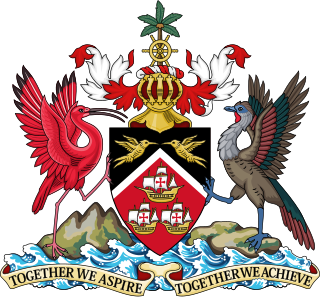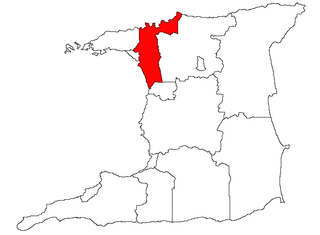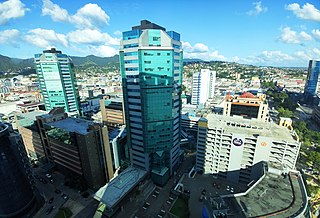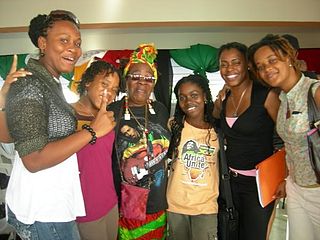Related Research Articles

The politics of Trinidad and Tobago function within the framework of a unitary state regulated by a parliamentary democracy modelled on that of the United Kingdom of Great Britain and Northern Ireland, from which the country gained its independence in 1962. Under the 1976 republican Constitution, the monarch was replaced as head of state by a President chosen by an electoral college composed of the members of the bicameral Parliament, consisting of the Senate and the House of Representatives.

The economy of Trinidad and Tobago is the third wealthiest in the Caribbean and the fifth-richest by GDP (PPP) per capita in the Americas. Trinidad and Tobago is recognised as a high-income economy by the World Bank. Unlike most of the English-speaking Caribbean, the country's economy is primarily industrial, with an emphasis on petroleum and petrochemicals. The country's wealth is attributed to its large reserves and exploitation of oil and natural gas.

Port of Spain, officially the City of Port of Spain, is the capital of Trinidad and Tobago and the third largest municipality, after Chaguanas and San Fernando. The city has a municipal population of 49,031, an urban population of 545,045 and a transient daily population of 250,000. It is located on the Gulf of Paria, on the northwest coast of the island of Trinidad and is part of a larger conurbation stretching from Chaguaramas in the west to Arima in the east with an estimated population of 600,000.

San Fernando, officially the City of San Fernando, is the most populous city and second most populous municipality in Trinidad and Tobago, after Chaguanas. Sando, as it is known to many local Trinidadians, occupies 19 km² and is located in the southwestern part of the island of Trinidad. It is bounded to the north by the Guaracara River, the south by the Oropouche River, the east by the Sir Solomon Hochoy Highway, and the west by the Gulf of Paria. The former borough was elevated to the status of a city corporation on 18 November 1988. The motto of San Fernando is: "Sanitas Fortis" - In a Healthy Environment We Will Find Strength. San Fernando is called Trinidad and Tobago's "industrial capital" because of its proximity to the Pointe-à-Pierre oil refinery and many other petrochemical, LNG, iron and steel and aluminium smelters in places such as Point Lisas in Couva, Point Fortin, and La Brea.

The Borough of Chaguanas is the largest municipality and fastest-growing town in Trinidad and Tobago. Located in west-central Trinidad, south of Port of Spain, north of Couva and San Fernando, and named after the indigenous tribe who originally settled there, it grew in size due to its proximity to the Woodford Lodge sugar refinery. It remained a minor town until the 1980s when it began to grow rapidly as it drew people for its bargain shopping and moderately priced housing. Its rapid growth has seen property values increase dramatically, however.
Couva is an urban town in west-central Trinidad, south of Port of Spain and Chaguanas and north of San Fernando and Point Fortin. It is the capital and main urban centre of Couva–Tabaquite–Talparo, and the Greater Couva area includes the Point Lisas industrial estate and the port of Point Lisas. It is one of the fastest-growing towns in the country. Couva's southern boundary is at the village of California and Point Lisas, and to the north Couva stretches to McBean. To the east of Couva is Preysal. To the west of Couva is the road to Waterloo and Carli Bay, which are located on the Gulf of Paria. Couva was part of the Caroni County. Couva is considered a major power base for the United National Congress, whose headquarters was previously located here.

Trinidad and Tobago, officially the Republic of Trinidad and Tobago, is the southernmost island country in the Caribbean. Consisting of the main islands Trinidad and Tobago and numerous much smaller islands, it is situated 11 kilometres off the coast of northeastern Venezuela and 130 kilometres south of Grenada. It shares maritime boundaries with Barbados to the east, Grenada to the northwest and Venezuela to the south and west. Trinidad and Tobago is generally considered to be part of the West Indies. The island country's capital is Port of Spain, while its largest and most populous city is San Fernando.

The Brian Lara Cricket Academy is a multi-purpose stadium in Tarouba, San Fernando, Trinidad and Tobago, that was completed and inaugurated in 2017. It will be used mostly for cricket matches. It is located in southern Trinidad, just outside the heart of the city of San Fernando, beside the Sir Solomon Hochoy Highway, about two kilometres southeast of Trinidad and Tobago's former cricket ground at Guaracara Park, Pointe-a-Pierre.

Penal–Debe region is a region of Trinidad. The local government body is Penal–Debe Regional Corporation, a Regional Corporation of Trinidad and Tobago. The region has a land area of 246.91 km². Urban areas within Penal–Debe include Penal, where the corporation is headquartered, and Debe. Indians make up the majority of the region with 71%, followed by minorities of Africans, Douglas, other multiracial, Europeans, Chinese, Amerindians, Portuguese, Arabs, and others. Hinduism is the largest religion in the region at 43%, followed by Christianity, Islam, not stated, others, Irreligion, Orisha-Shango, and Rastafari.

San Juan–Laventille is a region of Trinidad. It has a land area of 220.39 km². The San Juan–Laventille Regional Corporation is headquartered at MTS Plaza in Aranguez, San Juan. Other urban areas include Barataria, Laventille, Morvant and San Juan. It is the smallest region in Trinidad. The region is bordered by Port of Spain in the west to St. Joseph in the east.
The Copyright Music Organisation of Trinidad and Tobago (COTT) is a non-profit association representing people in the music industry of Trinidad and Tobago. COTT was incorporated in 1984 and began operating in 1985.

The Port of Spain International Waterfront Centre is a construction project aimed at revitalising and transforming the waterfront of the capital-city Port of Spain located in Trinidad and Tobago. The project is a part of the overall Vision 2020, a government policy attempting to take Trinidad and Tobago to developed country status by 2020. That policy has since been shelved. The towers, which were supposed to usher in the beginning of a "Financial Centre" never materialized, and have slowly been occupied by government departments and offices.

The Government Campus Plaza is a government complex on Richmond Street and Wrightson Road in Port of Spain, Trinidad and Tobago. Completed in May 2017, the Government Campus Plaza provides public access to the services of four major government ministries and agencies.

Lisa Wickham is a media producer-director-TV personality in Trinidad and Tobago. She began her television career at the age of six on the weekly Rikki Tikki Children's Show, a live programme on the only national TV station in Trinidad and Tobago at the time, Trinidad and Tobago Television (TTT). She literally grew up on national television, eventually hosting shows such as the daily morning prime-time news and talk show T&T This Morning, the daily mid-morning talk show Community Dateline and the iconic teen talent show Party Time. In 2005, the government of Trinidad and Tobago closed TTT and in 2006 re-opened the station under the name Caribbean New Media Group (CNMG). CNMG was then closed in 2018.

Fay-Ann Lyons-Alvarez is a Trinidadian soca recording artist and songwriter. She is also known by the stage names Lyon Empress, Mane the Matriarch, and the Silver Surfer, a nickname which she claimed during her performance at the 2008 International Soca Monarch. Personally she's married to Bunji Garlin.
The nation of Trinidad and Tobago has been the leading supporter of the Caribbean Community (CARICOM). Trinidad and Tobago was one of the four members in 1973 which then along with Barbados, Guyana and Antigua and Barbuda moved to establish the organisation that today it known as the Caribbean Community and Common Market. The new organisation because a successor to the Caribbean Free Trade Association (CARIFTA) by the Treaty of Chaguaramas, of which Trinidad and Tobago was a leading member and also a founding member.
Konza Technopolis, previously called Konza Technology City, is a large technology hub planned by the government of Kenya to be built 64 km south of Nairobi on the way to the port city of Mombasa. It is marketed as a key driver of Kenya's national development plan, known as Kenya Vision 2030. As of January 2019, the project appeared to be far behind schedule.

South Oropouche is a community in Trinidad and Tobago. It is at sea level. There is an archaeological site at St John's Road, South Oropouche. Dow Village is in South Oropouche.

Women in Trinidad and Tobago are women who were born in, who live in, or are from Trinidad and Tobago. Depending from which island the women came, they may also be called Trinidadian women or Tobagonian women respectively. Women in Trinidad and Tobago excel in various industries and occupations, including micro-enterprise owners, "lawyers, judges, politicians, civil servants, journalists, and calypsonians." Women still dominate the fields of "domestic service, sales, and some light manufacturing."

The Magnificent Seven is a group of seven mansions located west of the Queen's Park Savannah in northern Port of Spain, Trinidad and Tobago on Maraval Road in the St Clair neighborhood. They were built between 1902 and 1910 on land that was previously used as a government stock farm and are listed as heritage sites at the National Trust of Trinidad and Tobago. Stollmeyer's Castle was the first building in the neighborhood and took several years to complete, as was typical of the Magnificent Seven.
References
- 1 2 Urban Development Corporation of Trinidad and Tobago (UdeCOTT) Ministry of Planning and Development.
- ↑ (June 8, 2007), quarrel - Chinese contractors favoured over locals in Trinidad Jamaica Gleaner
- ↑ Trinidad and Tobago architects call for investigation into UDeCOTT Caribbean Net News.